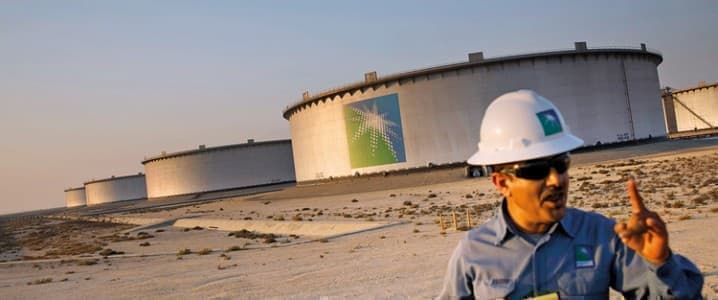Saudi Aramco’s profits fell by nearly 50% in 2020 as the pandemic battered oil markets and an oil price war between Russia and Saudi Arabia sent oil prices to record lows. Not even the world’s largest oil company could escape the devastation, although it did manage to remain profitable unlike many of its competitors. For Saudi Arabia, a country whose entire economy is virtually monopolized by the state-owned oil company, Aramco’s 44.4% drop in profits meant a whopping 30.7% decline in oil revenues for the Saudi government. Despite the sharp downturn, Saudi Aramco has continued to pay steady dividends to its shareholders. A portion of Aramco first went public in December of 2019 in what was the single biggest initial public offering in history. The vast majority of shares are owned by the national government, meaning that the oil company, as opposed to the Saudi State treasury, has taken the pandemic-led economic beating. The company reportedly saw its free cash flow fall from $78.3 billion in 2019 to just $49 billion in 2020. Chief Aramco executive Amin Nasser described 2020 as "one of the most challenging years in recent history."
While crude prices have made a considerable recovery since they hit rock bottom in April of last year, with prices now hovering over $60 per barrel, “analysts say the Saudi giant is bracing for possible further waves of COVID that could undermine a tentative global economic recovery,” German news media company DW reported last week. Ironically, the drop in oil profit is expected to hinder the petrostate’s ambitious plans to diversify the Saudi economy so that oil no longer rules Riyadh. It has been widely speculated that Crown Prince Mohammed bin Salman's (MBS) ambitious "Vision 2030" reform program could face serious delays or downscaling thanks to the state’s decline in oil revenues.
Related: The Future Of U.S. LNG Hangs In The Balance
Despite these hardships, Saudi Aramco’s CEO said on Wednesday that the company is on track to meet expected dividend payouts on the heels of the government’s announcement that Saudi Arabia will prioritize investments in the coming year. What’s more, the crown prince has said that his plans to diversify the Saudi economy will indeed move forward, albeit not under the "Vision 2030" banner. MBS announced on Tuesday that Saudi Aramco, together with Saudi petrochemical firm SABIC, will still be the biggest financial supporter of a 5 trillion riyal ($1.3 trillion) private sector investment plan to make the domestic economy less dependent on oil.
When the plans for “Vision 2030” were unveiled in 2017, Saudi finance minister Mohammed Al Jadaan told CNN, "We will not really care much whether the price is 40, 45, 50, 55 at that time because we have gone significantly out of our way to be independent of the oil price...We are planning to totally [end] that dependency that we have been living for the last 40, 50 years. Hopefully, by 2030, I wouldn't care if the oil price is zero." With nearly ten years to go, it’s clear that Saudi Arabia still cares very much whether the oil price is zero, and the 2020 downturn could easily compromise that vision for 2030 as well. Despite the volatile outlook, however, MBS, Nasser et al. are still remaining optimistic and cheerful - at least when talking to the media.
Related Video: Saudi Arabia Goes All-In on Hydrogen
“We are very excited with the government’s announcement yesterday of the Shareek program,” Nasser was quoted by CNBC. “We support this initiative which is very much aligned with Vision 2030. It promotes GDP growth through new investment and will have a multiplier effect for the Saudi economy.”
While MBS has said that the Saudi government had asked the largest firms participating in the program to cut dividends in order to redirect cash flow to these new hefty investments, he has continued to promise that Saudi Aramco shareholders will receive dividends at the levels they expect. “When asked how sustainable the company’s dividend would prove to be in the wake of the government’s private sector investment plans, Nasser said it was a ‘voluntary’ program that had taken private interests into consideration,” CNBC reported.
On the heels of the announcement, shares of Saudi Aramco traded nearly 2% higher on the Saudi stock exchange on Wednesday.
By Haley Zaremba for Oilprice.com
More Top Reads From Oilprice.com:
- Oil Prices Rise After OPEC+ Agrees To Gradually Increase Output This Summer
- The Future Of U.S. LNG Hangs In The Balance
- ExxonMobil Set To Outperform As Oil And Gas Prices Climb



















But whether under the banner of Saudi Vision 2030 or Shareek programme spearheaded by Saudi Aramco and SABIC, the diversification is dependent first and foremost on higher oil prices almost doubling current Saudi oil revenues.
Funds from the oil revenues will be needed to invest in major projects in support of the non-oil sector of the economy. Without that investment and therefore without higher oil prices exceeding $80 a barrel, the non-oil sector’s contribution to the Saudi economy will remain low and diversification won’t take off.
Yet, Saudi Aramco has no alternative but to pay the hefty dividend of $75 bn since 98% of its shares are owned by the government which depends on the dividend to plug any budget deficit and (in times of high oil revenues) to finance government expenditure and also capital investment.
The dividend is also vital for the Saudi public who own the remaining 2% for which they had been encouraged by the government to use their savings and even borrow money from the banks to buy shares in Aramco.
Dr Mamdouh G Salameh
International Oil Economist
Visiting Professor of Energy Economics at ESCP Europe Business School, London